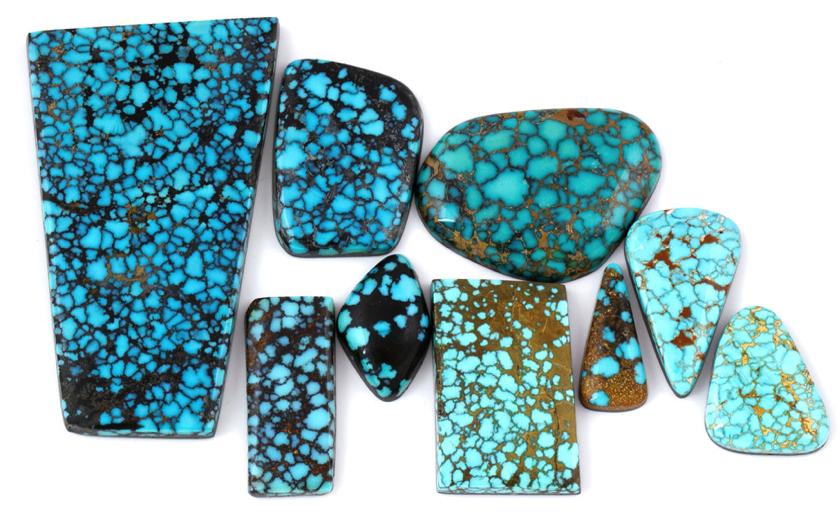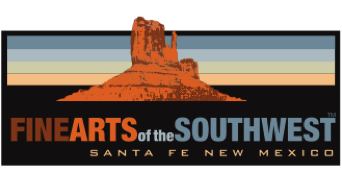
© 2010-2025 by Fine Arts of the Southwest, Inc. All rights reserved.
Unauthorized reproduction or use is strictly prohibited by law.
A particularly beautiful and finely-crafted Navajo tufa-cast silver and Indian Mountain, Nevada Spiderweb turquoise cuff bracelet by Jack Adakai, c. 1960’s-70’s
One of the better kept artistic secrets of the 20th century Southwest is the extremely talented and inventive Navajo silversmith, Jack Adakai (active 1950’s to 1981) who is well-known among connoisseurs of fine historic Navajo jewelry, but is not in any way a widely known “famous artist” in the sense of Charles Loloma or Kenneth Begay or his former apprentice and now International jewelry Superstar, McKee Platero. Adakai lived and worked quietly in the pre-internet, pre-social media age in the rural Gallup area of far western New Mexico near the Arizona border.
He worked at various times for the various prominent trading companies in the local area; C.G. Wallace, Tobe Turpen, M.L. Woodard and he also worked with the Foutz trading family of Farmington and Shiprock, NM.
Adakai’s work is characterized by its excellent and complete mastery of all traditional Navajo silversmithing techniques, such as tufa-casting, fabrication, stamp, chisel and file work. Adakai also incorporated a distinct Modernist clean-lined design sense into his traditional craftsmanship in much the same manner as Ambrose Roanhorse and his cohorts at the Navajo Arts and Crafts Guild had done in the 1940’s and 50’s. In addition to his own extremely formidable silversmithing abilities, Adakai was also an excellent teacher and mentor. In the late 1960’s and early 1970’s, he taught his young clan nephew and apprentice who is the now world-renowned Navajo silversmith, McKee Platero (b.1957). Jack Adakai is also the father and teacher of the well-known and well-regarded contemporary
Navajo silversmith, Ray Adakai.
The extremely elaborate fancy silver casting of this bracelet in a complex four-part design in front with repeated curvilinear designs down along the sides, somewhat resembling corn plants, and crowned with this extraordinary large and rare turquoise stone leads us to speculate that this bracelet might very possibly have been made on commission
as a special fancy piece intended for a particular and very special someone. Possibly, the renowned Zuni Indian trader, C.G. Wallace custom ordered it from Jack Adakai for a favored client of his high-end clientele or perhaps it was on
of the other prominent Gallup, NM traders who also regularly worked with Adakai, such as Tobe Turpen, Ernie Vanderwagen or M.L. Woodard. Whoever he might have been, the trader would have very likely provided Adakai with the gem stone and asked him to make a particularly impressive bracelet featuring it for the trader’s client. The owner of the Indian Mountain turquoise mine at this time was the important Nevada Turquoise Mine owner and turquoise dealer, J.W. Edgar who also had a retail trading post outlet in Gallup, Nm which is most likely how the stone got there.
The bracelet measures 1 1/8" in width at its center point, then tapers outwards on both sides along the shank to
its widest side points of 1 1/2" in width and then nicely tapers back in to 1" in width at the terminal ends. The inner circumference end-to-end is 5 1/4" and the gap between the terminals is 7/8" for a total interior circumference of 6 1/8". The bracelet weighs a solid, yet very comfortable and easily wearable 79 grams or 2 3/4 ounces and it is in completely excellent original vintage condition with some age-appropriate wear and a nice mellow patina. The bracelet is properly signed on the interior with Jack Adakai’s customary capital letters initials “J.A.” hallmark insignia.
This bracelet is a very visually exciting and most superbly-crafted special piece possibly originally made as a special order for a special someone. Perhaps you or your loved one will be the next special someone fortunate enough
to own it. No matter which of you it might be, you will both certainly enjoy having this precious, rare and lovely prize.
SOLD
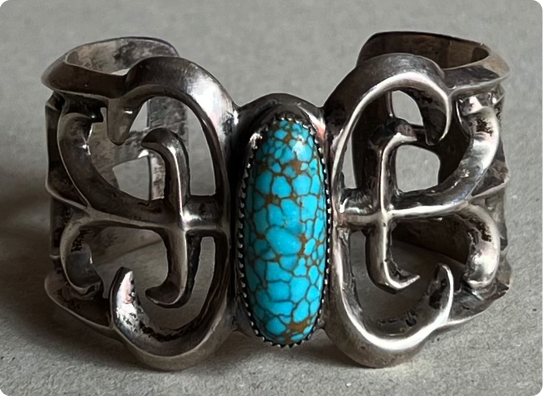
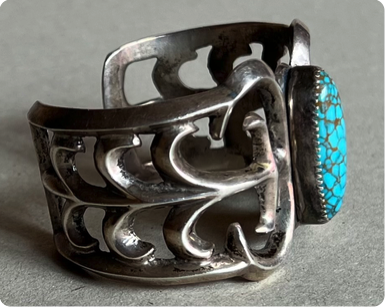
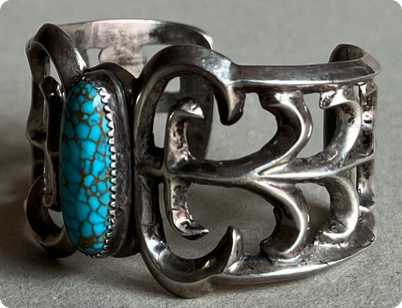
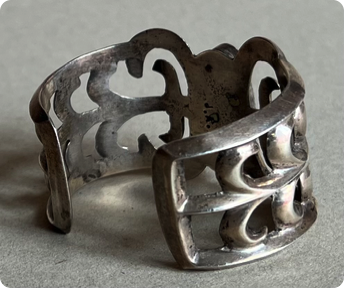
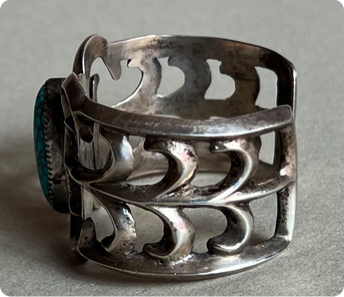

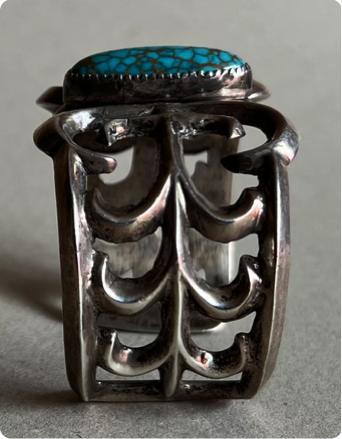
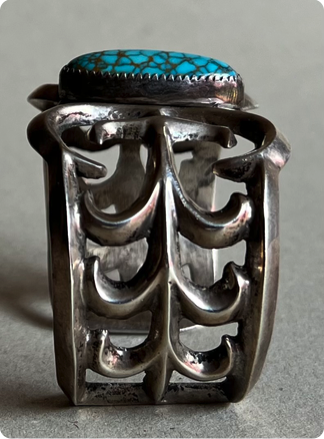
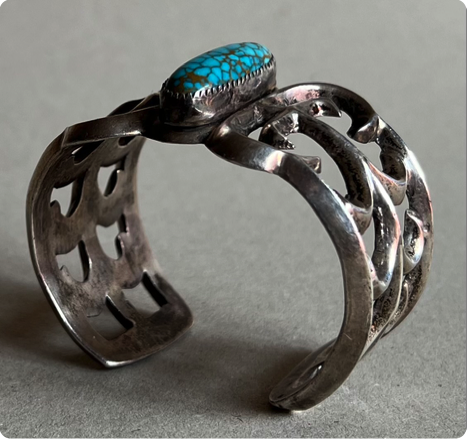
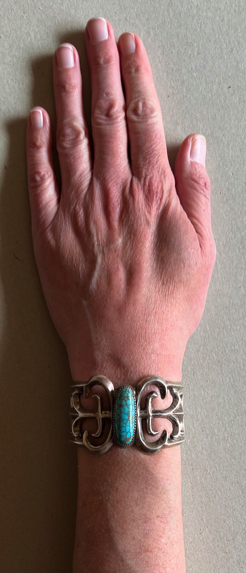
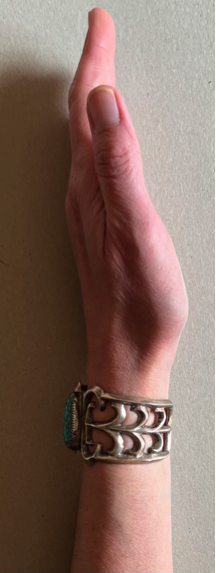
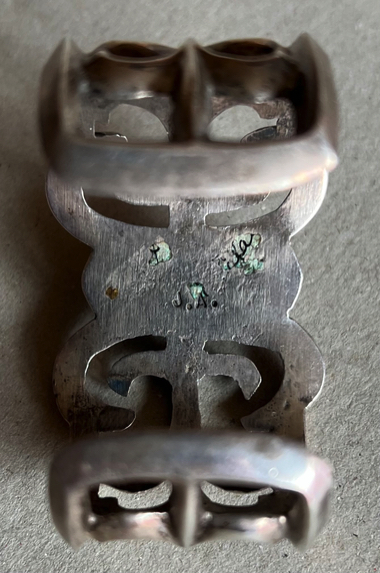
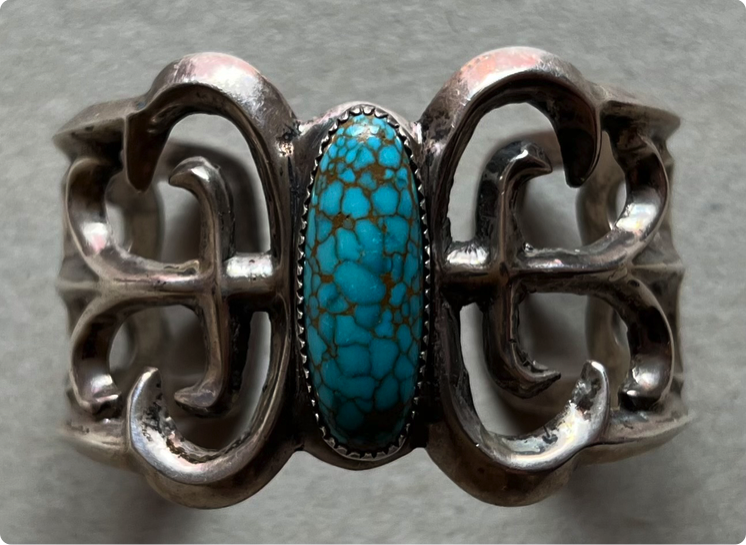
This wonderful bracelet is a particularly fine example of Jack Adakai’s exalted capabilities as witnessed by the elaborate artistically and technically superb work. The silver tufa-casting of the body of the bracelet here is simply extraordinary and extraordinarily difficult to achieve, conveying the ideal combination of delicacy and strength that
is the hallmark of fine tufa-casting. Featured prominently and vertically set in the bracelet’s front and center is a spectacular, large, oval-shaped, high-domed, gem-grade Indian Mountain, Nevada spiderweb turquoise stone. Considered one of the country’s finest varieties of turquoise, Indian Mountain spiderweb is extremely rare and highly collectable. The large high-domed turquoise stone is a radiant blueish-green in color with a beautiful, light reddish-brown background matrix and the stone itself measures 1 1/6" in length and 7/16" in width and it is most beautifully and appropriately set in a very finely-serrated silver bezel.
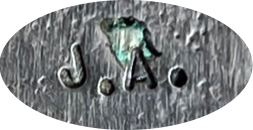

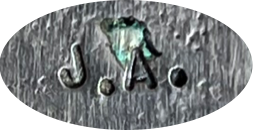
Indian Mountain Turquoise
A Indian Shoshone sheepherder was said to discovered the lode in 1970, on the south range of Bald Mountain in Lander County, Nevada where he stumbled upon a vein of turquoise on a hillside while tending his sheep. The Indian Mountain was owned and operated by Ed Mauzy and J.W. Edgar, both legends in Nevada turquoise mining. Mining at Indian Mountain was carried on from late May to early October with a recovery of “about three pounds” of good turquoise a day. During winter the mine could be covered up in 10 feet of snow. This mine hasn’t produced in over 20 years. Indian Mountain turquoise is rare and worth collecting
if you can find it. It produced both blue and green turquoise, sometimes combined, with brown to black spider web.
-Turquoise photo and text source and © Waddell Gallery, Scottsdale, Arizona
